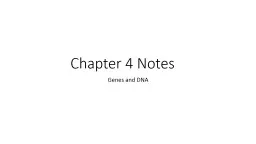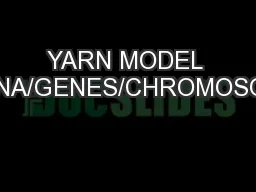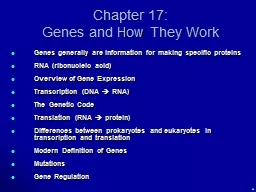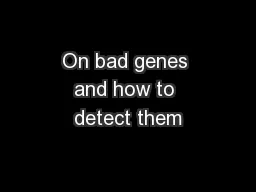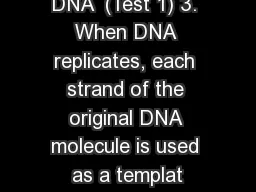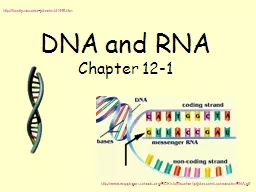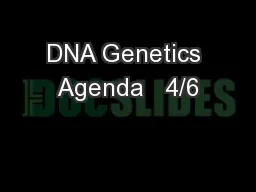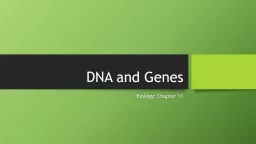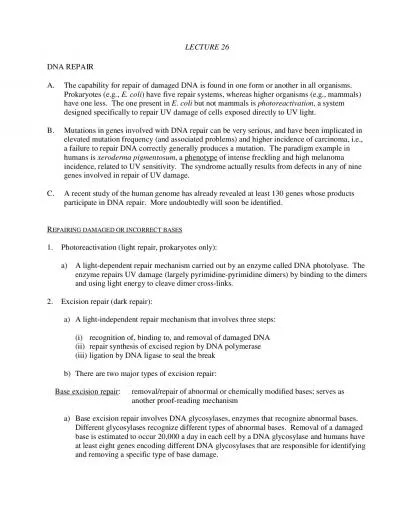PPT-Chapter 4 Notes Genes and DNA
Author : joedanone | Published Date : 2020-06-17
41 What does DNA Look Like Genes are part of the chromosome Chromosomes are made of protein and DNA DNA is the genetic material that determines inherited characteristics
Presentation Embed Code
Download Presentation
Download Presentation The PPT/PDF document "Chapter 4 Notes Genes and DNA" is the property of its rightful owner. Permission is granted to download and print the materials on this website for personal, non-commercial use only, and to display it on your personal computer provided you do not modify the materials and that you retain all copyright notices contained in the materials. By downloading content from our website, you accept the terms of this agreement.
Chapter 4 Notes Genes and DNA: Transcript
41 What does DNA Look Like Genes are part of the chromosome Chromosomes are made of protein and DNA DNA is the genetic material that determines inherited characteristics DNA is made of smaller components known as nucleotides. And 57375en 57375ere Were None meets the standard for Range of Reading and Level of Text Complexity for grade 8 Its structure pacing and universal appeal make it an appropriate reading choice for reluctant readers 57375e book also o57373ers students The yarn represents DNA.. DNA is a tiny, long, thin chemical. . How does the yarn resemble DNA?. If we looked closely at the . DNA inside each of your cells, . it would look like a twisted ladder. . Genes and How They Work. Genes generally are information for making specific proteins. RNA (ribonucleic acid). Overview of Gene Expression. Transcription (DNA . RNA). The Genetic Code. Translation (RNA . (Game from Univ. Utah). Siguna. Mueller. PhD student in BMS, Univ. Wyoming. What is DNA?. Each cell needs instructions for its role in the body. What do these instructions look like?. The instructions come in the form of a molecule called DNA.. Genetic Engineering. – the application of molecular genetics for practical purposes. Can be used to IDENTIFY or TRANSFER genes.. DNA Technology. – can be used to cure diseases, treat genetic disorders, improve food crops, etc.. 7. Lactose digestions in . E. coli. begins with its hydrolysis by the enzyme . -. galactosidase. , . lacZ. , is part of a . coordinatley. regulated operon containing the genes required for lactose utilization. Which of the following figures correctly depicts the interactions at the . http://faculty.uca.edu/~johnc/mbi1440.htm. http://www.wappingersschools.org/RCK/staff/teacherhp/johnson/visualvocab/mRNA.gif. GENETIC MATERIAL . In the middle of the 1900’s scientists were asking questions about genes.. Discuss backpacking project. Create genetics table of contents. Discuss essential question. Begin DNA and base pairing. Warm-Up: Make predictions in . yout. notebook. What does DNA stand for?. What is DNA made up of?. DNA damage DNA gets damaged a lot ! DNA damage DNA gets damaged a lot! >200,000 events/human cell/day DNA damage Occurs 2 ways 1) spontaneously 2) mutagens : damage DNA Transposons Discovered by Barbara McClintock Gene cloning and other techniques, collectively termed DNA technology, can be used to manipulate and analyze DNA and to produce useful new products and organisms.. In genetic engineering, bacterial restriction enzymes are used to cut DNA molecules within short, specific nucleotide sequences (restriction sites), yielding a set of double-stranded DNA fragments with single stranded sticky ends.. DNA. Deoxyribonucleic Acid (DNA). The genetic material. Contains the “blueprint” for an organism. Instructions for an organism’s traits. Nucleic Acid-polymer (chain) of nucleotides (monomers). Very long molecule. RNA is made of a long chain of nucleotides.. Differences between DNA and RNA:. 1 – the sugar on RNA is ribose instead of deoxyribose. 2 – RNA is generally single-stranded. 3 – RNA contains uracil in place of thymine. of intense freckling and high melanoma incidence, related to UV sensitivity. The syndrome actually results from defects in any of nine genes involved in repair of UV damage. C. EPAIRING DAMAGED OR . Knowing how many genes determine a phenotype (Mendelian and/or QTL analysis), and where the genes are located (linkage mapping) is a first step in understanding the genetic basis of a phenotype . A second step is determining the sequence of the gene (or genes).
Download Document
Here is the link to download the presentation.
"Chapter 4 Notes Genes and DNA"The content belongs to its owner. You may download and print it for personal use, without modification, and keep all copyright notices. By downloading, you agree to these terms.
Related Documents

